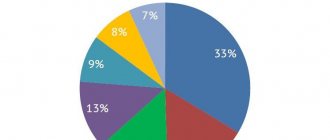Features of electricity tariffication in Russia
In our country, tariffs for providing homes with electricity are determined based on the rules and Government Decree No. 442. There are 6 tariff categories in total, each of which has features and restrictions.
Since, in this article, we set a goal to compare tariffs for country houses, so we will highlight aspects that will be of interest to summer residents and people living in cottages, without including the nuances of electrification of businesses and enterprises.
There are three main tariff categories for suburban real estate:
- When using the first price category, the amount for electricity is determined taking into account the meter readings at the end and beginning of the reporting period. In this case, ordinary counters are used;
- The second group contains tariffs, the calculation of which is carried out based on the time of day.
- There is a so-called three-zone accounting. When different rates are set for three segments of the day. In this case, in addition to electricity consumption during the day and night, peak load is taken into account.
To account for the energy consumption of each category, electricity meters of different types are installed.
Payment for electricity in 2021
defines that a tariff is a system of price rates at which payments for electricity are made. Regardless of the type of collection, they all have the same components.
Let's discuss in more detail what the electricity tariff is made up of. The price usually includes:
- electricity production price;
- price of resource transfer services;
- sales allowance. It is necessary for the operation of a sales company that buys electricity from the manufacturer and sells it to the end consumer;
- infrastructure payments.
The largest share – more than 60% – falls on the purchase of the resource. As we can observe, the price of electricity on the wholesale market in 2021 has become higher compared to the previous year.
It is followed by transportation and power transmission services. According to some data, they sometimes even exceed the cost of the resource itself and amount to more than 50%.
In last place is compensation for the costs of sales companies. As a rule, it takes no more than 1% of the final amount reaching the consumer.
Calculation of the tariff for electricity is carried out in accordance with the rules established
Check out what electricity tariffs are set for 2021.
How is electricity supplied to homes?
Electrical energy reaches the consumer through a network of relationships:
- Electricity generation is carried out by generating companies;
- Transportation is the responsibility of electric grid companies;
- And the connection and supply are handled by sales organizations and have the right to sell energy only if they are legally connected to the network.
Each supplier of last resort operates in a specific territory. Everyone is assigned to their own plot - this division is dictated by the need to ensure uninterrupted supply of electricity and not create competition between companies (which can lead to higher prices).
Of course, there are non-state sales companies. While remaining independent, they are each other's competitors. True, they do not have the right to formalize relationships with clients directly or offer rates below the market.
What is a two-part tariff?
This mode of electricity consumption is becoming increasingly popular today, as it allows you to save money at a time when you are not using lights and electrical appliances.
However, this does not mean that less energy is supplied to your home at night. Network companies simply adjust the load on power lines to distribute them evenly throughout the day and night.
This tariff is called two-rate because the tariff rate consists of two parts. The calculation formula is as follows:
- The basic payment is the amount that is received when calculating power units (roughly speaking, how many kW is supplied to the house);
- The amount of the surcharge depends on the number of hours consumed;
- The rate is determined by the cost of electricity.
What is a single-part tariff?
Today, the regulator of retail electricity markets at the legislative level is the Decree of the Government of the Russian Federation No. 442 of May 4, 2012. According to the document, six price categories are identified. The first category includes single-tariff meters.
A one-rate tariff for electricity is when the calculation of consumed electricity is carried out at a single rate, the unit of measurement of which is rubles per kWh. That is, the calculation of energy consumption is made by determining the difference between the readings given at the end and at the beginning of the month.
Difference between one-part and two-part tariff
1-rate tariffs include payment only for energy, and 2-rate tariffs include payment for energy and payment for capacity.
Let's take a closer look at these terms:
- Energy is the difference between the last and the initial value;
- Power represents the amount of energy expended in an hour. This parameter varies depending on the load on the electrical network, and is measured in the same way as energy, in kilowatts.
Additionally, when calculating the amount for one-rate and two-rate modes, different powers are used:
- generator - arithmetic average on working days (peak);
- transport - determined taking into account peak loads.
Transport power is calculated at certain hours, generating power remains unchanged due to the fact that peak periods become known over the next 30 days.
Important nuance: If you switch from a single-rate to a two-rate mode, accounting for another 30 days will be kept at a single-rate tariff.
Tariff change
Few consumers know that they have the right to choose a tariff (price category). According to clause 86, section V of the Decree of the Government of the Russian Federation No. 442 dated May 4, 2012, 6 price categories are established.
Features of established price categories:
- For categories 1 and 2, only consumed electrical energy is calculated.
- Tariffs 3 to 6 include indicators of power and electricity consumption.
Reference! For single-rate tariffs there are 1, 2, 3 and 5 price categories, and for two-rate tariffs only 4 and 6 .
For example, let’s consider the single-rate tariff for electricity in Moscow and the Moscow region, valid for 2021. There are three types of tariffs valid for houses and apartments:
- with installed gas stoves;
- equipped with electric stoves;
- objects located in rural areas.
Let's look at the summary table for single-tariff accounting using a single-rate tariff for 2021 in Moscow and the Moscow region:
| With gas stoves | With electric stoves | Countryside | |
| from January to June 30 | 5.38 | 3.77 | 3.77 |
| from July to December 31 | 5.56 | 3.89 | 3.89 |
If we consider the single-rate tariffs established in Yekaterinburg and the region, the indicators will be as follows:
| With gas stoves | With electric stoves | Countryside | |
| from January to June 30 | 3.96 | 2.77 | 2.77 |
| from July to December 31 | 4.08 | 2.86 | 2.86 |
As can be seen from the above data, price categories differ in different regions of the country. You can find out more information about your area on the official website of your energy supplier.
How to switch from a two-part tariff to a one-part tariff?
The consumer has the right to independently choose a tariff depending on the installed meter. The application must be submitted to the department of the energy supplier or through your management company 10 working days before the start of the new billing period.
In this case, a transition is allowed both from a two-rate tariff to a one-rate tariff, and in the reverse order.
If you have already exercised the right to switch from tariff to tariff, then we ask you to share your experience and leave a comment. Your opinion is very important to us and other users, because based on it we improve the service.
How much does electricity cost in the Moscow region?
Let's look at the average tariffs for residents of the Moscow region:
- The cost in single-bet mode will be 3.71 rubles. for one kilowatt;
- With a two-part rate, the price depends on the time: day – 4.26 rubles; night – 1.58 rubles;
- Three-rate mode: peak – 4.82 rubles; night – 1.57 rubles, half-peak zone – 3.71 rubles.
Do I need to switch to a multi-part tariff?
Most dacha and cottage settlements located in the Moscow region are equipped with single-tariff meters. At the moment, only a fifth of consumers have multi-rate meters installed.
Why is this happening? Let's assume that many people are simply not sure that this will work out cheaper or simply do not know about these possibilities. It is also worth noting that when choosing a 2-rate tariff, it is quite difficult for home owners to accurately predict how much energy they will consume during the day and how much at night.
The two-rate mode is definitely suitable for night owls (who stay awake at night or wake up late). Since the size of the electricity bill at the end of the month depends on what time of day the household appliances are used (boiler, electric pump, heating, kettle, TV, dishwasher and washing machine).
For early risers (and most of those who live on a 6-21 or 7-22 schedule), single-rate counters will be more profitable.
Electricity tariffs in Moscow
In Moscow, there are lower tariffs than in the region. The data is provided in the ratio RUB/kWh, VAT is already taken into account.
Please note that other payment systems may charge additional fees for making payments. When paying with Visa, MasterCard and Mir cards on the website or in your Mosenergosbyt personal account, no commission is charged. Read more about payment methods by following this link.
The process of transferring a country house to a multi-tariff meter
First of all, you decide on the meter model, then make a request to the village administration and Mosenergosbyt (for residents of the Moscow region). They send you a technician who will install everything in 1 day, you just have to pay the costs and sign the papers.
Costs when switching to a 2- or 3-rate tariff will be as follows:
- Purchasing an electronic meter (its price is higher than a regular one);
- Regular reprogramming of the device;
- Prepayment for the use of electricity.
Important: Whatever type of meter you choose, its installation and sealing must be carried out by an electrician certified by Mosenergosbyt. It is strictly prohibited to install the equipment yourself.
The amount of expenses can also be affected by the number and power of equipment with which the cottage is equipped. With the right calculations, you can make smart choices. This provides the benefits of differential metering.
What price categories are there?
First price category
The purchase price of power on the Wholesale Electricity Market is already taken into account in the price of electricity, so the consumer pays for the entire volume consumed for the month at one price, in one line on the electricity bill. Electricity transmission is included in the price at a single rate tariff. This price category is available only to small consumers, with a maximum power receiving device of less than 670 kW.
Consumers who have not notified the supplier of last resort about the choice of category are calculated according to the first price category (if calculations were made in a different price category in the previous year, then this price category automatically passes for him to the next year.
Second price category
Power is also included in the price of electricity as in the first category, however, the bill will have two or three prices, depending on which option of the second price category was chosen by the consumer, it can be two-zone (day/night) and three-zone (peak/half-peak/night ). Transmission is also taken into account at a single rate tariff; the price category is also not available for consumers over 670 kW.
Calculations in the second price category are carried out for each day zone separately. Then all received values are summed up. There are three zones of the day: peak, half-peak and night. Accordingly, electricity is cheaper at night, but much more expensive during peak hours. The second price category is chosen by those consumers who work primarily at night (bakeries, nightclubs, etc.).
It is worth noting that in order for the consumer to be able to choose the second price category, the electricity meters that are installed must provide the ability to meter electricity by zone of the day (multi-tariff meter). Such a metering device costs from 1,500 rubles per piece.
The intervals of tariff zones of the day (the hour from which a particular range begins and the hour at which it ends) are established by SO UES by the corresponding order for each year for each subject of the Russian Federation.
Third price category
In all price categories except the first and second, electricity is paid by the hour; the electricity bill has two lines - electricity and power. Electricity is charged at different prices every hour, so hourly electricity metering is required to operate at these price points. The transmission tariff is taken into account at a single rate, as in the first and second price categories. For the third price category, they include the component of transporting electricity to the consumer (the price of delivering electricity, so to speak), but the price for power does not include it. It is worth noting that electricity prices are 1 and 2 c.k. by default include the component of transporting electricity to the consumer.
Fourth price category
Electricity is paid for by the hour; a separate fee for power is charged, as in the third price category. However, transmission is already included in the price at a two-rate tariff, that is, the rate for the maintenance of networks and the rate for losses in the networks are paid separately, while the rate for losses is usually included by the supplier in the price of electricity. Therefore, the invoice usually has three lines: electricity, power purchase and power transmission. “Power transmission” is the payment of a rate for the maintenance of a two-rate transmission tariff. This price category is available to all legal entities – consumers of electricity – without exception.
The only difference between the fourth price category and the third is that, as mentioned above, in the third price category the price of electricity includes the component of transporting electricity to the consumer (the price of delivering electricity, so to speak), but the price of power does not. In the fourth price category, everything is a little different.
A consumer who has chosen the 4th price category is required to pay the following components:
Electricity for each hour, while its price includes payment for transport only partially (the component for payment of electricity of the two-rate tariff for the provision of services for the transmission of electricity through electric networks. What is a two-rate tariff for the provision of services for the transmission of electricity is discussed above);
Power paid for on the wholesale market. Its price does not include payment for electricity transportation;
Transmitted power. Its price is the rate for the capacity of the two-rate tariff for the provision of services for the transmission of electricity through electrical networks.
So, the main difference between the fourth price category and the third is that for the third price category the cost of electricity transportation is included entirely in the cost of electricity (the price of power does not contain this transport component), and for the fourth price category the cost of electricity transportation is included in both the cost of electricity , and into the cost of power, by adding transmitted power to the calculations. In other words, the price of electricity for the fourth price category is significantly lower than for the third price category, but the price of power for the fourth price category will be higher than for the third.
Fifth price category
The fifth price category is for volumes of electricity (capacity) purchases, for which hourly planning and accounting are carried out during the billing period, and the cost of electricity transmission services is determined at a single-rate tariff.
The principle of calculations in the fifth price category is very similar to the third, but there is one significant difference: the consumer must plan his consumption for the month hourly and send this data to the supplier in advance.
Thus, if in the third price category calculations are made for the actual volumes of electricity consumption, then in the fifth the consumer pays both the actual volumes of consumption and the cost of deviations.
It is worth noting that the price for actual calculations in the fifth price category is approximately 5-7% lower than for the third price category. Therefore, if you plan your consumption wisely, you can reduce the final cost of electricity.
The cost of power for the fifth price category is calculated in the same way as for the third price category.
Sixth price category
Calculations for the sixth price category are similar to calculations for the fourth price category. The only difference (as well as the fifth from the third price category) is the need to plan hourly consumption and provide this data to the supplier. Calculations in the sixth price category are made both for the actual volumes of consumption and for the deviation of the fact from the plan.
Hourly planning, hourly accounting, and a two-rate tariff for electricity transmission services are required.
Training seminars and consulting services from our group - we will help you figure it out or do it for you! Tariff setting, cost of electricity, conventional units and much more! Looking for a solution to a problem? Please.
How to choose the optimal tariff?
To select the appropriate energy consumption mode, the consumer needs to find out the current tariffs used in his locality. For residents of the Moscow region, you should contact Mosenergosbyt.
The total cost of electricity will depend on:
- type of settlement: city, village, SNT, etc.;
- the presence or absence of gas supply: to heat a house without gas, owners have to look for alternatives: in 90% of cases these are appliances that consume electricity;
- tariff rate, calculation method.
You can predict electricity costs in a country house based on information about all available modes.
Is it possible to wind/twist the counter?
Meters are needed to prevent theft. If violations are detected, administrative penalties are imposed on the owner who ignored the electricians’ demands.
When installing an electricity meter, be sure to take into account the condition of the wiring in the house. If the current does not exceed 100 amperes, it is recommended to choose a direct connection meter. If this indicator is higher, it is recommended to purchase equipment installed via transformer current.
conclusions
The multi-tariff mode of energy consumption in a country house is beneficial if a person permanently lives in a holiday village. This transition will lead to expected savings in the event of excessive energy consumption or constant occupancy during the daytime.
If the owner of the dacha does not intend to come to the village often, there is no need to change the tariff. Especially if the house has electric heating devices and electric stoves. Changing the tariff in this case may lead to increased costs.
Therefore, before purchasing a meter and choosing an energy consumption mode in your country cottage, it is best not to make hasty decisions and consult with a highly specialized specialist.
Did you find this article helpful? Please share it on social networks: Don't forget to bookmark the Nedvio website. We talk about construction, renovation, and country real estate in an interesting, useful and understandable way.






